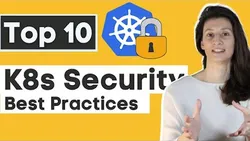
Kubernetes Security Best Practices you need to know THE Guide for securing your K8s cluster! 
This guide provides an overview of Kubernetes security best practices, from image scanning to network policies. It explains the importance of security in the cloud and how it applies to Kubernetes. It also outlines four key best practices, including running as a non-root user, using RBAC for users and permissions, and using network policies. These best practices help ensure the security of your Kubernetes cluster. ▼
ADVERTISEMENT
Course Feature
![]() Cost:
Cost:
Free
![]() Provider:
Provider:
Youtube
![]() Certificate:
Certificate:
Paid Certification
![]() Language:
Language:
English
![]() Start Date:
Start Date:
On-Demand
Course Overview
❗The content presented here is sourced directly from Youtube platform. For comprehensive course details, including enrollment information, simply click on the 'Go to class' link on our website.
Updated in [February 21st, 2023]
This course provides an overview of Kubernetes security best practices. It begins with an introduction to security in the cloud and security in Kubernetes. It then covers security as a spectrum, and provides best practices for image scanning, running as a non-root user, users and permissions with RBAC, using network policies, encrypting communication, securing secret data, securing etcd, automated backup and restore, configuring security policies, and disaster recovery.
[Applications]
After completing this course, users should be able to apply the Kubernetes Security Best Practices to their own K8s clusters. This includes scanning images, running as a non-root user, using Role-Based Access Control (RBAC) for users and permissions, using network policies, encrypting communication, securing secret data, securing etcd, configuring automated backups and restores, configuring security policies, and planning for disaster recovery.
[Career Paths]
1. Kubernetes Security Engineer: Kubernetes Security Engineers are responsible for ensuring the security of Kubernetes clusters. They are responsible for implementing security best practices, such as image scanning, running as non-root user, using network policies, encrypting communication, securing secret data, securing etcd, configuring security policies, and automating backup and restore. This role is becoming increasingly important as organizations move to the cloud and adopt Kubernetes.
2. Cloud Security Architect: Cloud Security Architects are responsible for designing and implementing security solutions for cloud-based applications and services. They must be knowledgeable in the latest security technologies and trends, and must be able to develop and implement security policies and procedures. This role is becoming increasingly important as organizations move to the cloud and adopt Kubernetes.
3. DevOps Security Engineer: DevOps Security Engineers are responsible for ensuring the security of DevOps processes and tools. They must be knowledgeable in the latest security technologies and trends, and must be able to develop and implement security policies and procedures. This role is becoming increasingly important as organizations move to the cloud and adopt DevOps and Kubernetes.
4. Cloud Security Analyst: Cloud Security Analysts are responsible for monitoring and analyzing cloud security threats and vulnerabilities. They must be knowledgeable in the latest security technologies and trends, and must be able to develop and implement security policies and procedures. This role is becoming increasingly important as organizations move to the cloud and adopt Kubernetes.
[Education Paths]
Recommended Degree Paths:
1. Bachelor of Science in Cybersecurity: This degree program provides students with the knowledge and skills needed to protect computer networks and systems from cyber threats. It covers topics such as network security, cryptography, digital forensics, and ethical hacking. This degree is becoming increasingly popular as the demand for cybersecurity professionals grows.
2. Master of Science in Information Security: This degree program focuses on the technical aspects of information security, such as cryptography, network security, and digital forensics. It also covers topics such as risk management, security policy, and incident response. This degree is ideal for those who want to specialize in the field of information security.
3. Doctor of Philosophy in Cybersecurity: This degree program is designed for those who want to pursue a career in research and teaching in the field of cybersecurity. It covers topics such as cryptography, network security, digital forensics, and ethical hacking. This degree is ideal for those who want to become experts in the field of cybersecurity.
Developing Trends:
1. Cloud Security: Cloud security is becoming increasingly important as more organizations move their data and applications to the cloud. As such, there is a growing demand for professionals who are knowledgeable in cloud security.
2. Artificial Intelligence and Machine Learning: Artificial intelligence and machine learning are becoming increasingly important in the field of cybersecurity. Professionals who are knowledgeable in these technologies will be in high demand.
3. Internet of Things (IoT) Security: As the number of connected devices increases, so does the need for professionals who are knowledgeable in IoT security. Professionals who are knowledgeable in this area will be in high demand.
Course Provider

Provider Youtube's Stats at AZClass
Discussion and Reviews
0.0 (Based on 0 reviews)
Explore Similar Online Courses

Learn Power Bi - Analyze & Visualize Data with Power Bi - P2

How to use the Facebook Conversion API with Google Tag Manager Server-Side

Python for Informatics: Exploring Information

Social Network Analysis

Introduction to Systematic Review and Meta-Analysis

The Analytics Edge

DCO042 - Python For Informatics

Causal Diagrams: Draw Your Assumptions Before Your Conclusions

Whole genome sequencing of bacterial genomes - tools and applications

Kubernetes for Beginners (Kubernetes + Docker)

Scalable Microservices with Kubernetes


Start your review of Kubernetes Security Best Practices you need to know THE Guide for securing your K8s cluster!